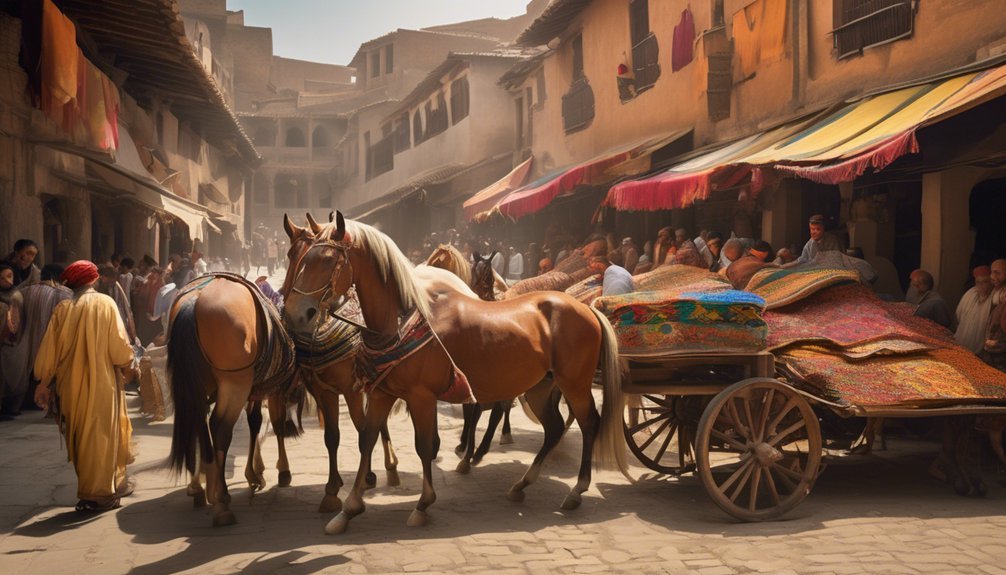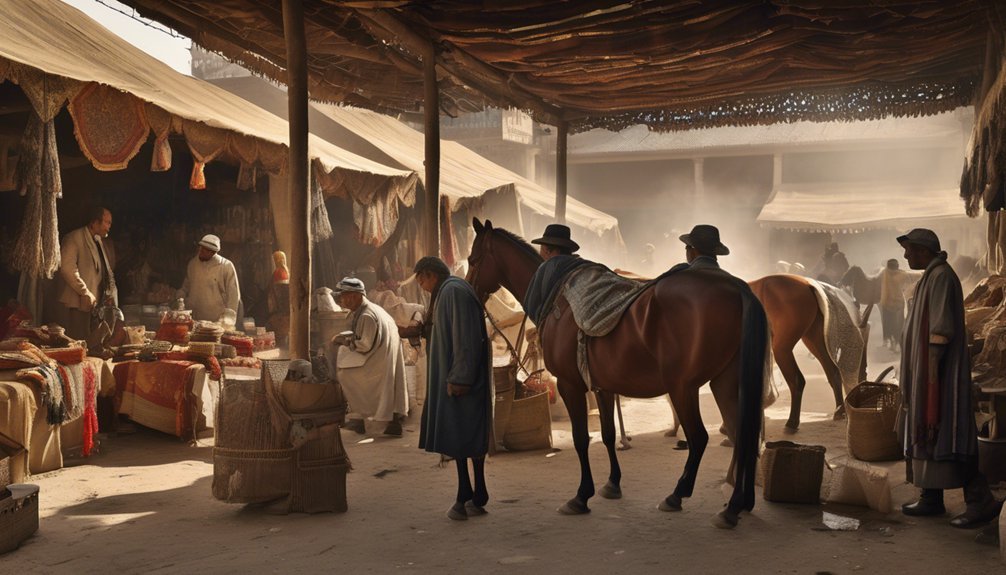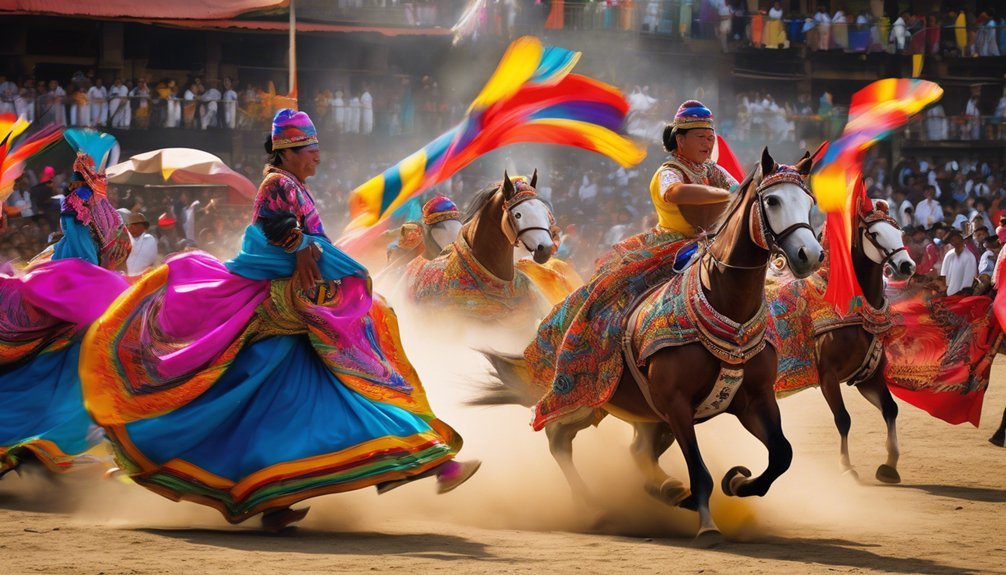
Imagine a merchant on the Silk Road, relying on sturdy horses to transport silk and spices across treacherous terrains. These animals didn't just carry goods; they transformed trade dynamics by enabling faster, more efficient exchanges. As you explore the intricate relationships between horses and ancient commerce, you'll uncover how they influenced economic structures, cultural exchanges, and even social hierarchies in ways that shaped societies far beyond their immediate reach. What drove this profound impact?
Key Takeaways
- Horses enabled faster and more efficient delivery of goods, significantly enhancing logistics in ancient trade.
- Skilled riders and superior horse breeds facilitated reliable transport across challenging terrains, boosting trade volumes.
- Cultural exchange occurred along trade routes, with horses symbolizing power and wealth in various societies.
- Innovations in horse equipment, such as improved harnesses and saddles, increased cargo capacity and travel speed.
- The presence of horses expanded trade networks and contributed to the growth of local and regional economies.
The Role of Horses in Transportation and Logistics

While many ancient societies relied on various means of transportation, horses emerged as a pivotal asset in logistics and trade.
Horse-drawn transport revolutionized how goods were moved, enabling faster and more efficient delivery compared to traditional methods. You'd notice that the strength and stamina of horses allowed for heavier loads and longer journeys, making them integral to equine logistics.
This capability transformed local economies and facilitated broader trade networks. Furthermore, the adaptability of horses to diverse terrains meant that routes could expand, connecting distant communities.
The bond between humans and these animals was essential, as it combined skill and intuition, ensuring that goods reached their destinations promptly.
In essence, horses were indispensable in shaping the landscape of ancient commerce.
Horses in Trade Routes: The Silk Road and Beyond
Horses played a crucial role in the logistics of ancient trade routes, particularly along the Silk Road.
Their speed and endurance allowed for the efficient transport of goods across vast distances, facilitating cultural exchange and commerce.
Understanding how horses enhanced trade route operations provides insight into their impact on economic development in ancient societies.
Role of Horses
In the bustling exchange of goods along the Silk Road and other ancient trade routes, horses served as vital conduits for commerce and cultural interaction. Your understanding of their role can be enhanced by focusing on several key aspects:
- Transport: Horses carried goods over vast distances, linking diverse regions.
- Horse Breeding: The development of superior breeds ensured reliability and endurance for long journeys.
- Equestrian Skills: Skilled riders navigated challenging terrains, enhancing trade efficiency.
- Cultural Exchange: Horses facilitated interactions among traders, spreading ideas and customs.
Through these elements, horses not only supported trade but also fostered connections that transcended borders, shaping the tapestry of ancient economies and societies.
Their impact is a testament to their indispensable role in commerce.
Trade Route Logistics
As trade flourished along the Silk Road and other ancient routes, the logistics of transporting goods became paramount to success. Effective route management played a crucial role in ensuring that commodities reached their destinations efficiently.
Horses were indispensable in navigating the vast terrains, but they also introduced logistical challenges. The need for proper care, feeding, and rest for these animals significantly impacted travel times and routes. Merchants had to strategize their journeys, accounting for weather conditions, terrain difficulties, and the availability of supplies.
The interplay between horse mobility and route management defined not just the speed of trade but also the economic prosperity of civilizations. By mastering these logistics, traders enhanced their networks and solidified their positions in the global economy.
Economic Impact of Horses on Ancient Markets
While many ancient societies relied on various forms of trade, the integration of horses into these markets significantly transformed economic dynamics.
The horse economy enhanced trade efficiency, allowing for faster transportation and larger cargo loads. Here are four key impacts:
- Increased Trade Volume: Horses enabled merchants to carry more goods over longer distances, expanding market reach.
- Cost Reduction: With horses, traders could reduce reliance on manpower, lowering transport costs.
- Market Expansion: Access to new regions became feasible, fostering trade relationships across cultures.
- Economic Stability: A robust horse economy contributed to consistent supply chains, stabilizing prices and availability of goods.
Cultural Exchange and Horses in Trade
As you explore the role of horses in ancient trade, you'll notice how trade routes facilitated not just the exchange of goods but also cultural interactions.
Different horse breeds emerged, reflecting the unique practices and values of the cultures that nurtured them, which in turn influenced economic activities.
Understanding these connections reveals the profound impact horses had on societies beyond their economic contributions.
Trade Routes and Horses
Trade routes in ancient times served as vital conduits for cultural exchange, facilitating not only the movement of goods but also ideas and practices, with horses playing a central role in this dynamic.
These majestic animals shaped trade dynamics in significant ways:
- Transportation of Goods: Horses enabled quicker and more efficient transport of trade items across vast distances.
- Cultural Exchange: As merchants traveled, they shared traditions, languages, and technologies along the routes.
- Economic Development: Horse-based trade networks stimulated local economies, leading to the rise of towns and markets.
- Diversity of Horse Breeds: Different regions developed unique horse breeds, each adapted to their environments, enhancing trade capabilities.
These elements illustrate how horses were integral not only to commerce but to the broader fabric of ancient societies.
Horse Breeds and Cultures
Horses, adapted to diverse environments, not only influenced trade routes but also became symbols of cultural identity across various regions.
Arabian horses, prized for their endurance, epitomized the elegance of Middle Eastern cultures, while Mongolian ponies represented the rugged spirit of the steppes.
The Thoroughbred influence spread across Europe, enhancing horse breeding practices and establishing new transportation methods.
Draft horses became essential for agricultural tasks, showcasing their utility in trade partnerships.
Each breed carries cultural symbolism, reflecting the values and lifestyles of their origins.
As you explore these connections, it's clear that horses served not just as transportation but as vital links in the tapestry of ancient commerce, fostering relationships through shared practices and mutual respect among diverse cultures.
Economic Impact of Horses
While examining the economic impact of horses, it's essential to recognize how they facilitated cultural exchange across ancient trade networks.
The horse economy played a crucial role in shaping societies, influencing everything from commerce to cultural interactions. Here are four key aspects:
- Trade Routes: Horses enabled faster transportation, connecting distant markets and cultures.
- Resource Distribution: They allowed for the exchange of goods like spices, textiles, and metals, enhancing interregional commerce.
- Cultural Exchange: The equine trade introduced new ideas, art, and technologies as people interacted along trade routes.
- Social Structures: Horses also influenced social hierarchies, as ownership often reflected wealth and status.
The Social Hierarchy and Horses in Commerce

As societies developed in the ancient world, the role of horses in commerce became intricately linked to the prevailing social hierarchy.
Horses represented not just transportation but also a symbol of power and wealth. Those in higher social strata often enjoyed greater access to quality horses, enhancing their equestrian status. This access allowed them to dominate trade routes, fostering social mobility for those who could afford to invest in equine assets.
In contrast, lower classes faced limitations, relying on less efficient means for trade. The ability to harness horse power directly influenced one's position within the social fabric, creating a clear divide.
Thus, horses weren't merely tools; they were pivotal in shaping social dynamics and economic opportunities in ancient commerce.
Innovations in Horse Equipment and Their Influence on Trade
Innovations in horse equipment significantly transformed trade practices in the ancient world by enhancing efficiency and expanding the capabilities of merchants.
These advancements in horse gear brought about several key improvements:
- Harness Innovations: Enhanced harness designs allowed horses to pull heavier loads, increasing cargo capacity.
- Saddle Design: Improved saddles provided better rider stability, facilitating effective riding techniques.
- Transportation Advancements: Streamlined equipment reduced drag, leading to mobility improvements for quicker travel between markets.
- Equestrian Efficiency: Better gear led to reduced fatigue for horses, thereby extending their endurance and market accessibility.
These innovations not only optimized trade enhancements but also revolutionized how goods were transported, paving the way for more interconnected economies in the ancient world.
Frequently Asked Questions
What Breeds of Horses Were Preferred for Trade in Ancient Times?
In ancient trade, you'd find Arabian Stallions favored for their speed and endurance, while Celtic Ponies were appreciated for their adaptability and strength. Each breed played a critical role in facilitating commerce and transportation needs.
How Did Horses Influence the Development of Ancient Cities?
You might think horses just trotted around, but they actually spurred urban expansion. Their role in transportation networks allowed cities to grow, connecting trade routes and enabling commerce, ultimately shaping the very fabric of ancient civilization.
Were There Laws Regulating Horse Trade in Ancient Civilizations?
You'll find that ancient market practices often included horse trade regulations. These laws aimed to ensure fair transactions, maintain quality, and protect both buyers and sellers, reflecting the significance of horses in their economies and societies.
What Challenges Did Traders Face When Using Horses for Commerce?
When you rely on horses for trade, you'll face transportation difficulties and logistical challenges. Weather, terrain, and horse health can affect your routes, making timely deliveries complex and sometimes jeopardizing your entire trade operation.
How Did Horses Impact Social Status in Ancient Trading Communities?
In ancient trading communities, horses represented equine symbolism, enhancing your social hierarchy. Owning a fine steed elevated your status, signaling wealth and power, while influencing trade dynamics and relationships within the community, fostering both admiration and envy.
Conclusion
In conclusion, horses were the lifeblood of ancient trade, galloping through history as powerful agents of commerce. Their ability to transport goods across daunting terrains not only boosted trade volume but also wove a rich tapestry of cultural exchange. As innovations in equestrian equipment emerged, they transformed commerce, allowing for the blossoming of interconnected markets. Ultimately, horses bridged distant lands, shaping economies and societies in ways that echo through time, reminding us of their enduring legacy in human progress.





